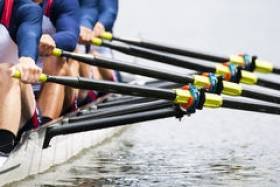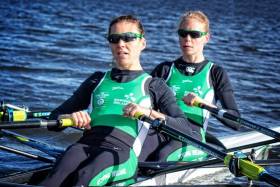Displaying items by tag: O'Brien
Ireland Crews Win at World Masters Rowing
#Rowing: Irish crews were amongst the winners again at the World Masters Regatta in Denmark today. Denis Crowley of Commercial and Niall O’Brien of Carlow won in the men’s single sculls for competitors 50 years or more and the Belfast Boat Club women’s coxed four (average age 60 or more) also won.
World Masters Regatta, Copenhagen (Irish interest - Winners; 1,000m)
Men
Single Sculls - D (average age 50 years or more) - Heat Two: Carlow Rowing Club (N O’Brien) 3:58.63. Heat 10: Commercial (D Crowley) 4:08.63.
Women
Four, coxed - F (average age 60 years or more) - Heat One: Belfast Boat Club 4:42.79.
Jennings and Lambe Win C Final at World Cup in Varese
#Rowing: Sinéad Jennings and Claire Lambe ended their campaign at the World Cup Regatta in Varese with a commanding performance to win the C Final of the lightweight double sculls. They led all the way and were four lengths clear of nearest rivals, Italy Three, at the finish.
Ireland had two competitors in the repechage of the women’s lightweight single sculls. There were two places on offer in an A Final, but Poland and Switzerland One took these. Siobhán McCrohan finished fifth and Denise Walsh sixth. In the lightweight men’s four, Ireland battled it out for third in the C Final with Austria, losing out by .15 of a second. In the C Final of the women’s pair, Leonora Kennedy and Barbara O’Brien finished third. Norway pipped Ukraine to win.
World Cup Regatta, Varese – Day Two (Selected Results, Irish interest)
Men
Lightweight Four – C Final (places 13 to 16): 1 Canada One 6:09.73, 2 Serbia 6:11.21, 3 Austria 6:15.85, 4 Ireland (L Seaman, M O’Donovan, L Keane, S O’Driscoll) 6:16.00.
Women
Pair – C Final (places 13 to 16): 1 Norway One 7:22.74, 2 Ukraine 7:23.16, 3 Ireland (L Kennedy, B O’Brien) 7:33.07.
Lightweight Double Sculls – C Final (places 13 to 17): 1 Ireland (C Lambe, S Jennings) 7:17.24, 2 Italy Three 7:26.29, 3 Chile 7:29.71.
Lightweight Single Sculls – Repechage (First Two to A Final; rest to B Final): 1 Poland Two 7:49.90, 2 Switzerland One 7:51.76; 5 Ireland Two (S McCrohan) 8:04.69, 6 Ireland One (D Walsh) 8:08.81
Trinity College Prepares for Rowing Blitz
#Rowing: The inaugural rowing blitz for those who are new to the sport of rowing will take place this Friday, November 13th at Trinity College, Dublin. More than 400 competitors from around Ireland are set to take part. The event will not only give students the opportunity to test themselves as indoor rowers in a competitive environment for the first time, it will also give these youngsters a feel for what university life has to offer.
RTÉ news2day will attend the event.
The day will feature talks from former Olympian and World Championship medalist Neville Maxwell, physiotherapist and Trinity lecturer Dr Fiona Wilson – who will deal with rowing posture – and Sally O'Brien, won the women's senior eights championships in with Trinity (Dublin University Ladies' Boat Club) in 2015.
The winner of each category will receive a trophy and medals sponsored by Leinster branch of Rowing Ireland. Each category of winners will also receive free entry into the Irish Indoor Rowing Championships, which will be held at the University of Limerick sports arena in January.
The event will be facilitated by students rowing at Trinity college, together with over 70 students who have trained up over the last months to be Rowing Ireland transition year coaches.
Racing will start at 10am and the programme will finish at 2pm.
Kennedy and O'Brien Win Women's Pair Trial
# Rowing: Leonora Kennedy and Barbara O’Brien won the women’s pair final at the Ireland trial at the National Rowing Centre, beating the combination of Monika Dukarska and Aifric Keogh. Michael Maher, a former lightweight international, competed in the heavyweight single and won that final. Paul O’Donovan was the convincing winner of the lightweight single, while his brother and partner in the lightweight double, Gary, was second, 19 seconds back. Sanita Puspure won her heat of the heavyweight single convincingly and was exempted from having to compete in a final.
Ireland Trial, National Rowing Centre, Cork, Sunday (Selected Results; Finals unless stated):
Men
Pair: UCD 7:21.23.
Single Sculls: 1 M Maher 7:56.61, 2 S McKeown 7:59.18, 3 R Byrne 8:02.46
Lightweight Single: 1 P O’Donovan 7:22.63, 2 G O’Donovan 7:41.77, 3 S O’Driscoll 7:48.99.
Women
Pair: 1 L Kennedy, B O’Brien 8:10.35, 2 M Dukarska, A Keogh 8:19.19.
Single Sculls – (Heat): S Puspure 7:50.46. Under-23: 1 E Hegarty 8:56.88, 2 E Lambe 9:11.60, 3 M Cremin 9:16.75.
Lightweight Single: 1 C Lambe 8:17.22, 2 Sarah Dolan 8:26.55, 3 D Walsh 8:27.77.
| Rowing Ireland - October Trials - Result of Finals |
| 12:30 |
| W2- |
| Final |
| 1 |
| Portora/UCC |
| 8:10:35 |
| 2 |
| Killorglin/UCC |
| 8:19:19 |
| 12:35 |
| WB1X |
| Final B |
| 1 |
| Lee - Synnott |
| 9:18:23 |
| 3 |
| UCC - O'Sullivan |
| 9:33:98 |
| 2 |
| Lee - Littlewood |
| 9:39:52 |
| 12:40 |
| WB1X |
| Final A |
| 1 |
| Skibbereen - Hegarty |
| 8:56:88 |
| 3 |
| UCD - Lambe |
| 9:11:60 |
| 2 |
| Lee - Cremin |
| 9:16:75 |
| 4 |
| Belfast - Blundell |
| 9:28:03 |
| 12:45 |
| M1X |
| Final C |
| 2 |
| Fermoy - Morrison |
| 8:16:64 |
| 3 |
| Shandon - O'Sullivan |
| 8:21:23 |
| 1 |
| Killorglin - Crowley |
| 8:21:81 |
| 4 |
| Portadown - Laivins |
| 8:51:18 |
| 12:50 |
| M1X |
| Final B |
| 2 |
| UCD - Hughes |
| 7:58:71 |
| 1 |
| UCC - Casey |
| 8:01;91 |
| 3 |
| Castleconnell - Whittle |
| 8:09:53 |
| 4 |
| Lee - Larkin |
| 8:13:00 |
| 12:55 |
| M1X |
| Final A |
| 3 |
| Commercial - Maher |
| 7:56:51 |
| 4 |
| Portadown - McKeown |
| 7:59:18 |
| 2 |
| Shandon - Byrne |
| 8:02:46 |
| 1 |
| OCBC - Neale |
| DNF |
| 13:05 |
| MS2- |
| Final |
| 0 |
| UCD 2- |
| 7:21:23 |
| 13:05 |
| WL1X |
| Final |
| 3 |
| OCBC - Lambe |
| 8:17:72 |
| 1 |
| Commercial - Dolan |
| 8:26:55 |
| 4 |
| Skibbereen - Walsh |
| 8:27:77 |
| 2 |
| Tribesman - McCrohan |
| 8:46:96 |
| 0 |
| Belfast - Quinn |
| 8:54:04 |
| 13:10 |
| LM1X |
| Final D |
| 1 |
| Cork - O'Connell |
| 8:08:19 |
| 3 |
| Skibbereen - Ryan |
| 8:09:69 |
| 2 |
| Shandon - Merz |
| 8:13:87 |
| 4 |
| Shandon - Channon |
| 8:20:34 |
| 13:15 |
| LM1X |
| Final C |
| 2 |
| Shandon - Prendergast |
| 7:59:09 |
| 1 |
| Shandon - Lonergan |
| 8:09:78 |
| 4 |
| UCC - Synnott |
| 8:16:14 |
| 3 |
| Skibbereen - McCarthy (J) |
| 8:21:42 |
| 13:20 |
| LM1X |
| Final B |
| 1 |
| St Michael's - O'Connor |
| 7:52:90 |
| 2 |
| Shandon - Hennessy |
| 7:57:56 |
| 3 |
| NUIG - Keane |
| 7:58:49 |
| 4 |
| Waterford - Goff |
| 8:01:08 |
| 13:25 |
| LM1X |
| Final A |
| 1 |
| Skibbereen - O'Donovan (P) |
| 7:22:63 |
| 2 |
| Skibbereen - O'Donovan (G) |
| 7:41:77 |
| 3 |
| Skibbereen - O'Driscoll |
| 7:48:99 |
| 4 |
| Skibbereen - McCarthy (F) |
| 8:00:48 |
Conference Reveals State of Marine Leisure Industry
With boat sales falling by as much as 80%, marina business down 20%, retail sales in chandlery down up to 38%, insurance down 12.5% the marine industry in Ireland and Wales had to take some action to ensure the marine trade and leisure industry survives.
An unusual industry conference took place in Dun Laoghaire today and yesterday with the objective of understanding where the industry is right now and how it needs to act to ensure that it survives the downturn in our economies.
Over 125 marine businesses from both sides of the Irish Sea will be attending in what will be the largest marine leisure Industry gathering ever brought together.
A joint address was given by the Executive Director of the British Marine Federation, Howard Pridding and David O'Brien the Chairman of the Irish Marine Federation set the scene as to where the industry is on both sides of the Irish Sea.
The conference heard from 3 companies who operate in the sector. One from each region, North Wales, South Wales and Ireland who will share with the conference their experiences in the current economic climate on how they are surviving and thriving in the downturn. Business tactics that need to be deployed were explored with a leading business and innovation specialist from Wales together with joint talks by Visit Wales and Failte Ireland on the development of marine leisure tourism.
Leading economist Jim Power delivered a talk on the economic situation and when we might begin to see some consumer confidence return to our markets.
The Pembroke Coastal Forum told how they have managed their coastline and environment and how they have facilitated marine leisure tourism through proper marine spatial planning.
The conference is being organised by irish-sea.org and Ireland/Wales Interreg IV A Programme funded by the European Region Development Fund.
Irish-sea.org has three partners, North Wales Watersports, South West Wales Marine Federation and the Irish Marine Federation.































































